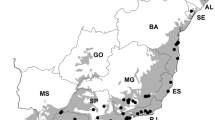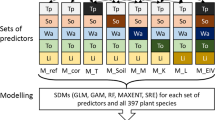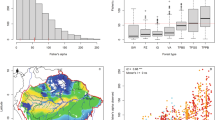Abstract
The degree to which variation in plant community composition (beta-diversity) is predictable from environmental variation, relative to other spatial processes, is of considerable current interest. We addressed this question in Costa Rican rain forest pteridophytes (1,045 plots, 127 species). We also tested the effect of data quality on the results, which has largely been overlooked in earlier studies. To do so, we compared two alternative spatial models [polynomial vs. principal coordinates of neighbour matrices (PCNM)] and ten alternative environmental models (all available environmental variables vs. four subsets, and including their polynomials vs. not). Of the environmental data types, soil chemistry contributed most to explaining pteridophyte community variation, followed in decreasing order of contribution by topography, soil type and forest structure. Environmentally explained variation increased moderately when polynomials of the environmental variables were included. Spatially explained variation increased substantially when the multi-scale PCNM spatial model was used instead of the traditional, broad-scale polynomial spatial model. The best model combination (PCNM spatial model and full environmental model including polynomials) explained 32% of pteridophyte community variation, after correcting for the number of sampling sites and explanatory variables. Overall evidence for environmental control of beta-diversity was strong, and the main floristic gradients detected were correlated with environmental variation at all scales encompassed by the study (c. 100–2,000 m). Depending on model choice, however, total explained variation differed more than fourfold, and the apparent relative importance of space and environment could be reversed. Therefore, we advocate a broader recognition of the impacts that data quality has on analysis results. A general understanding of the relative contributions of spatial and environmental processes to species distributions and beta-diversity requires that methodological artefacts are separated from real ecological differences.




Similar content being viewed by others
References
Arbeláez MV, Duivenvoorden JF (2004) Patterns of plant species composition on Amazonian sandstone outcrops in Colombia. J Veg Sci 15:181–188
Austin MP (2002) Spatial prediction of species distribution: an interface between ecological theory and statistical modelling. Ecol Modell 157:101–118
Balvanera P, Lott E, Segura G, Siebe C, Islas A (2002) Patterns of β-diversity in a Mexican tropical dry forest. J Veg Sci 13:145–158
Blanchet G, Legendre P, Borcard D (2007) Forward selection of explanatory variables. Ecology (in press)
Borcard D, Legendre P (2002) All-scale spatial analysis of ecological data by means of principal coordinates of neighbour matrices. Ecol Modell 153:51–68
Borcard D, Legendre P (2004) SpaceMaker2––user’s guide. Département de sciences biologiques, Université de Montréal. http://www.bio.umontreal.ca/legendre/
Borcard D, Legendre P, Avois-Jacquet C, Tuomisto H (2004) Dissecting the spatial structure of ecological data at multiple scales. Ecology 85:1826–1832
Borcard D, Legendre P, Drapeau P (1992) Partialling out the spatial component of ecological variation. Ecology 73:1045–1055
ter Braak CJF, Smilauer P (1998) CANOCO reference manual and user’s guide to CANOCO for Windows. Software for canonical community ordination. Version 4. Centre for Biometry, Wageningen
Brown N, Jennings S, Wheeler P, Nabe-Nielsen J (2000) An improved method for the rapid assessment of forest understorey light environments. J Appl Ecol 37:1044–1053
Cannon CH, Leighton M (2004) Tree species distributions across five habitats in a Bornean rain forest. J Veg Sci 15:257–266
Casgrain P (2001) Permute! Version 3.4 user’s manual. Département de sciences biologiques, Université de Montréal, Montreal
Chust G, Chave J, Condit R, Aguilar S, Lao S, Pérez R (2006) Determinants and spatial modeling of tree β-diversity in a tropical forest landscape in Panama. J Veg Sci 17:83–92
Clark DA, Clark DB, Sandoval M R, Castro C MV (1995) Edaphic and human effects on landscape-scale distributions of tropical rain forest palms. Ecology 76:2581–2594
Clark DB, Palmer MW, Clark DA (1999) Edaphic factors and the landscape-scale distributions of tropical rain forest trees. Ecology 80:2662–2675
Corney PM, Le Duc MG, Smart SM, Kirby KJ, Bunce RGH, Marrs RH (2006) Relationships between the species composition of forest field-layer vegetation and environmental drivers assessed using a national scale survey. J Ecol 94:383–401
Cottenie K (2005) Integrating environmental and spatial processes in ecological community dynamics. Ecol Lett 8:1175–1182
Dalle SP, López H, Díaz D, Legendre P, Potvin C (2002) Spatial distribution and habitats of useful plants:an initial assessment for conservation on an indigenous territory Panama. Biodivers Conserv 11:637–667
Dalling JW, Muller-Landau HC, Wright SJ, Hubbell SP (2002) Role of dispersal in the recruitment limitation of neotropical pioneer species. J Ecol 90:714–727
Denslow JS (1987) Tropical rainforest gaps and tree species diversity. Annu Rev Ecol Syst 18:431–451
Dirzo R, Horvitz CC, Quevedo H, López MA (1992) The effects of gap size and age on the understorey herb community of a tropical Mexican rain forest. J Ecol 80:809–822
Dray S, Legendre P, Peres-Neto PR (2006) Spatial modelling: a comprehensive framework for principal coordinate analysis of neighbour matrices (PCNM). Ecol Modell 196:483–493
Duivenvoorden JF (1995) Tree species composition and rain forest-environment relationships in the middle Caquetá area Colombia NW Amazonia. Vegetatio 120:91–113
Duque A, Sánchez M, Cavallier J, Duivenvoorden JF (2002) Different floristic patterns of woody understorey and canopy plants in Colombian Amazonia. J Trop Ecol 18:499–525
Duque AJ, Duivenvoorden JF, Cavelier J, Sanchez M, Polanía C, León A (2005) Ferns and Melastomataceae as indicators of vascular plant composition in rain forests of Colombian Amazonia. Plant Ecol 178:1–13
Fine PVA, Mesones I, Coley PD (2004) Herbivores promote habitat specialization by trees in Amazonian forests. Science 305:663–665
Gilbert B, Lechowicz MJ (2004) Neutrality niches and dispersal in a temperate forest understory. Proc Natl Acad Sci USA 101:7651–7656
Hall JS, McKenna JJ, Ashton PMS, Gregoire TG (2004) Habitat characterizations underestimate the role of edaphic factors controlling the distribution of Entandrophragma. Ecology 85:2171–2183
Harms KE, Condit R, Hubbell SP, Foster RB (2001) Habitat associations of trees and shrubs in a 50-ha neotropical forest plot. J Ecol 89:947–959
Hofton MA, Rocchio LE, Blair JB, Dubayah R (2002) Validation of Vegetation Canopy Lidar sub-canopy topography measurements for a dense tropical forest. J Geodyn 34:491–502
Holmgren PK, Holmgren NH (1998 onwards) [continuously updated]. Index Herbariorum. New York Botanical Garden. http://sciweb.nybg.org/science2/IndexHerbariorum.asp
Hubbell SP (2001) The unified neutral theory of biodiversity and biogeography. Princeton University Press, Princeton
John R, Dalling JW, Harms KE, Yavitt JB, Stallard RF, Mirabello M, Hubbell SP, Valencia R, Navarrete H, Vallejo M, Foster RB (2007) Soil nutrients influence spatial distributions of tropical tree species. Proc Natl Acad Sci USA 104:864–869
Jones MM, Tuomisto H, Clark DB, Olivas P (2006) Effects of mesoscale environmental heterogeneity and dispersal limitation on floristic variation in rain forest ferns. J Ecol 94:181–195
Karst J, Gilbert B, Lechowicz MJ (2005) Fern community assembly: the roles of chance and the environment at local and intermediate scales. Ecology 86:2473–2486
Legendre P, Gallagher ED (2001) Ecologically meaningful transformations for ordination of species data. Oecologia 129:271–280
Legendre P, Borcard D, Peres-Neto PR (2005) Analyzing beta diversity: partitioning the spatial variation of community composition data. Ecol Monogr 74:435–450
Moran RC, Riba R (eds) (1995) Flora Mesoamericana, vol 1. Psilotaceae a Salviniaceae. Universidad Nacional Autónoma de México, Mexico
Oksanen J, Kindt R, Legendre P, O’Hara RB (2007) vegan: community ecology package version 1.8–5. http://cc.oulu.fi/∼jarioksa/
Peres-Neto PR, Legendre P, Dray S, Borcard D (2006) Variation partitioning of species data matrices: estimation and comparison of fractions. Ecology 87:2614–2625
Phillips OL, Núñez Vargas P, Lorenzo Monteagudo A, Peña Cruz A, Chuspe Zans M-E, Galiano Sánchez W, Yli-Halla M, Rose S (2003) Habitat association among Amazonian tree species: a landscape-scale approach. J Ecol 91:757–775
Potts MD, Ashton PS, Kaufman LS, Plotkin JB (2002) Habitat patterns in tropical rain forests: a comparison of 105 plots in northwest Borneo. Ecology 83:2782–2797
Poulsen AD, Tuomisto H, Balslev H (2006) Edaphic and floristic variation within a 1-ha plot of lowland Amazonian rain forest. Biotropica 38:468–478
R Development Core Team (2006) R: A language and environment for statistical computing. R Foundation for Statistical Computing, Vienna, ISBN 3–900051-07-0, http://www.R-project.org
Svenning J-C, Kinner DA, Stallard RF, Engelbrecht BMJ, Wright SJ (2004) Ecological determinism in plant community structure across a tropical forest landscape. Ecology 85:2526–2538
Svenning J-C, Skov F (2005) The relative roles of environment and history as controls of tree species composition and richness in Europe. J Biogeogr 32:1019–1033
Thomsen RP, Svenning J-C, Balslev H (2005) Overstorey control of understorey species composition in a near-natural temperate broadleaved forest in Denmark. Plant Ecol 181:113–126
Tuomisto H (2006) Edaphic niche differentiation among Polybotrya ferns in Western Amazonia: implications for coexistence and speciation. Ecography 29:273–284
Tuomisto H, Poulsen AD (2000) Pteridophyte diversity and species composition in four Amazonian rain forests. J Veg Sci 11:383–396
Tuomisto H, Ruokolainen K, Kalliola R, Linna A, Danjoy W, Rodriguez Z (1995) Dissecting Amazonian biodiversity. Science 269:63–66
Tuomisto H, Poulsen AD, Ruokolainen K, Moran RC, Quintana C, Celi J, Cañas G (2003a) Linking floristic patterns with soil heterogeneity and satellite imagery in Ecuadorian Amazonia. Ecol Appl 13:352–371
Tuomisto H, Ruokolainen K, Yli-Halla M (2003b) Dispersal environment and floristic variation of Western Amazonian forests. Science 299:241–244
Valencia R, Foster RB, Villa G, Condit R, Svenning J-C, Hernández C, Romoleroux K, Losos E, Magård E, Balslev H (2004) Tree species distributions and local habitat variation in the Amazon: large forest plot in eastern Ecuador. J Ecol 92:214–229
Vormisto J, Svenning J-C, Hall P, Balslev H (2004) Diversity and dominance in palm (Arecaceae) communities in terra firme forests in the western Amazon basin. J Ecol 92:577–588
Wyatt JL, Silman MR (2004) Distance-dependence in two Amazonian palms: effects of spatial and temporal variation in seed predator communities. Oecologia 140:26–35
Acknowledgements
We thank Rigoberto Gonzalez for assisting during the fern inventory, and Jens Mackensen and Edzo Veldkamp for soil data collection. Diana and Milton Lieberman kindly allowed us access to their study areas. La Selva Biological Station of the Organization for Tropical Studies provided logistic support. Jérôme Chave, Michael Kessler and three anonymous reviewers provided helpful comments on the manuscript. The work was funded by grants from the Academy of Finland (to H. Tuomisto), the Andrew W. Mellon foundation (to D. B. and D. A. Clark), and NSERC (grant number OGP0007738 to P. Legendre). Inventories and specimen collection complied with Costa Rican law. Research permits were kindly granted by SINAC-MINAE.
Author information
Authors and Affiliations
Corresponding author
Additional information
Communicated by Katherine Gross.
Rights and permissions
About this article
Cite this article
Jones, M.M., Tuomisto, H., Borcard, D. et al. Explaining variation in tropical plant community composition: influence of environmental and spatial data quality. Oecologia 155, 593–604 (2008). https://doi.org/10.1007/s00442-007-0923-8
Received:
Accepted:
Published:
Issue Date:
DOI: https://doi.org/10.1007/s00442-007-0923-8




